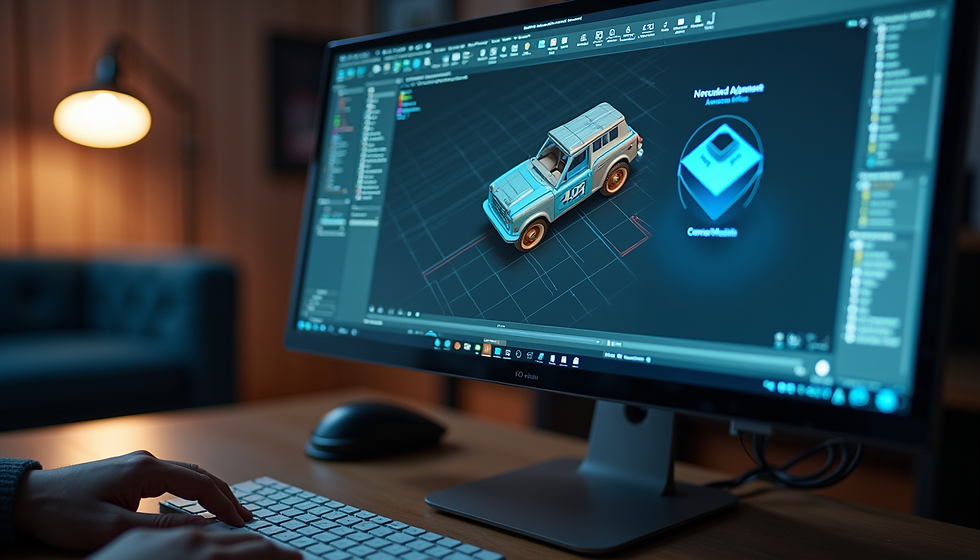Why You Need to Embrace 3D Digital Garments for a Smoother Manufacturing Process
- chinmayee n
- Mar 19
- 4 min read
In the fast-paced world of the garment industry, keeping up with technology has never been more crucial. The rise of 3D digital garments has transformed how clothes are designed and produced. For manufacturers who are finding it tough to stay relevant, adopting this technology is essential. Embracing 3D design isn't just innovative; it's a strategic move that can help you thrive in a competitive market.
The Shift to Digital in Garment Production
Traditional garment production often involves slow processes that require numerous steps like designing drafts, creating physical samples, and using up excess materials. This old-fashioned approach can inflate costs, extend lead times, and harm the environment.
3D digital garments revolutionize production by allowing designers to create and visualize garments in a virtual setting. For example, brands like Adidas have reported reducing sample-making costs by 80% after integrating 3D technology. Imagine being able to tweak a design without cutting any fabric. This not only cuts down on waste but also speeds up the time it takes to move from concept to production.
Digital garments allow for rapid prototyping. Instead of waiting weeks for samples to arrive, manufacturers can quickly make adjustments based on immediate feedback. This efficiency can significantly reduce your time to market, enabling you to respond to trends faster.
Benefits of 3D Digital Garments in Manufacturing
Enhanced Visualization
3D digital garments allow you to see a more realistic version of the finished product than sketches or flat designs. High-quality rendering software can display textures, patterns, and colors that mimic actual fabrics.
When clients see a lifelike representation of a garment, their trust in your production capabilities grows. For instance, a study showed that brands using 3D visualization reported a 30% increase in customer engagement. This can lead to more orders and higher customer satisfaction.
Cost-Effective Solutions
Using 3D technology can save manufacturers significant amounts of money by cutting down on sample production and material waste. In traditional manufacturing, creating multiple physical samples can be costly—often adding thousands of dollars to project budgets if designs require multiple revisions.
Switching to a digital process means you can create and test various design iterations before committing them to physical production, keeping unnecessary expenses at bay. This not only preserves your budget but also allows for strategic resource management.
Speedy Turnaround Times
Fashion trends are changing at lightning speed. Being the first to launch a new product can significantly affect your market presence.
Integrating 3D digital garments can cut down the design and approval phases, speeding up the time from concept to consumer. Reports indicate that companies implementing 3D technology can reduce lead times by as much as 50%. This agility in manufacturing helps you stay ahead of your competitors.
Quality Control and Consistency
Quality control is critical in garment manufacturing. Digital garments provide a high level of precision that can be challenging to achieve through traditional methods.
When properly utilized, 3D software allows you to spot potential flaws early in the design phase. This proactive approach ensures that the final product aligns with rigorous quality standards, helping you meet the expectations of discerning customers.
Environmental Impact
Sustainability is a hot topic today for both consumers and regulations. Using 3D digital garments can make your production processes more eco-friendly by significantly reducing fabric waste.
Research shows that around 92 million tons of textile waste is produced globally each year. By transitioning to more sustainable technologies, you position yourself as a responsible manufacturer, appealing to environmentally-conscious consumers and potentially increasing your market share.
Adapting to Changing Consumer Preferences
Today's shoppers want personalized and unique clothing options. 3D digital garments make it easier to offer customizable designs that resonate with individual tastes.
With this technology, you can provide bespoke designs, improving customer satisfaction and creating strong brand loyalty. A report from McKinsey states that companies offering customizable options see a 15% increase in customer retention.
Challenges and Solutions in Adopting 3D Digital Garments
While the advantages of 3D digital garments are clear, there are challenges to adopting this new technology. Transitioning from traditional methods can feel overwhelming, especially for manufacturers who may not be tech-savvy.
Investing in training for your design and production teams is crucial during this transition. Familiarizing them with the necessary software and technologies will ensure a smoother changeover. Providing support and resources during this phase can build confidence in using these innovative tools effectively.
Making the Switch Today
The garment industry is on the brink of a digital revolution, and if you're struggling as a manufacturer, now is the time to adapt. Embracing 3D digital garments can significantly enhance your processes and help you seize future growth opportunities.
By transitioning now, you can enjoy immediate benefits in efficiency and cost, all while positioning yourself for success in the evolving industry landscape. Remember, adaptability has always been crucial for thriving in fashion, and today is the perfect time to pivot towards innovation.

Embrace the future of garment manufacturing—it’s here, and it’s exciting.




Comments